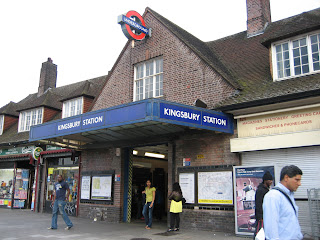I like the way its trains make a sleek, gentle revving sound when they leave the platform, and a weirdly becalming sighing noise when they pull to a stop. I like the fact the carriages look and feel really new, because they are (dating from 1996), unlike the Northern Line carriages which look and feel really rank, despite also dating from 1996.
I like the line's colour: silver. I like the name, because it refers to an event rather than a place. And I like its implausible route, being shaped by expediency and happenstance and illogic, which leads to it binding together the most disparate of places: genteel suburbs, hectic interchanges, unbecoming backwaters, forgotten tourist attractions and above all loads and loads of stations that used to belong to someone else.
The line kicks off with a whole slew of these which, even more appealingly, are all above ground. After the dungeon-esque horrors of the Victoria Line, this was a real relief.
Indeed, this entire first leg of my journey was in the open air - and entirely through stations that were once the property of not one, but two different owners.
The whole of the Jubilee Line north of Baker Street was once part of the Bakerloo Line, up until 1979 when the Jubilee was officially "born". But before the Bakerloo took up residency from 1939, it was the run as part of the Metropolitan Line. Hence when you travel south from Stanmore, you're running along tracks that have masqueraded under more different names than anywhere else on the Underground network.
It starts off as a very pleasant excursion through pure suburbia. Until you get to Wembley Park there's no real urban sprawl in sight. Stanmore itself was built as a terminus and has stayed that way ever since, replete with the eccentricity of having a ticket office downstairs at platform level and the booking hall upstairs at street level, where you can find a bank of old fashioned public telephones that nobody uses.
They're in the process of adding a third platform to the station. As it is, it's a sprawling, spacious terminus with that slightly giddy feeling of being on the edge of nowhere. It's very well kept, though, as is its neighbour, Canons Park.
This opened like its predecessor in 1932, but under the rather fussy name of Canons Park (Edgware).
At least this title did have some local resonance; the next one down the line, Queensbury, wasn't named after anything at all, conceived merely as complement its own neighbouring station, Kingsbury. It does, however, boast this rather wonderful construction just outside its main entrance:
What it's there for I've no idea, but it does look ace. Here's a long line of people, all of whom watched me take the above photo before finding themselves the stars of this one:
Queensbury was clearly an add-on to the existing line, opening two years later than all the stations north of Wembley Park. Indeed, Kingsbury feels a far more established and logical presence, sitting on a main road yet with platforms cleverly sunk below large verges covered in woodland.

Only when you get to Wembley Park does the Jubilee Line start to feel suitably regal. For here, surely, is one of the greatest stations on the entire network. Wembley Park is magnificent: a cavernous, palatial-esque playground with extraordinary flights of steps to rival any cathedral.
To arrive here ahead of a crucial football match must be one of the most thrilling feelings in the world. There's a stunning view upon exiting of the new Wembley Stadium arch. It really is the perfect introduction to a couple of hours in the company of several hundred thousand people watching a national team forget how to win.
The station dates back to 1893, but its current incarnation only opened last year, in a ceremony blessed by the presence of Ken Livingstone (naturally) and David Seaman (er...). Even more excitingly, mainline London to Aylesbury trains run *underneath* its platforms.
After all that, Neasden can only be an anti-climax. Which it is.
Opened in 1880, it was first called Kingsbury and Neasden, then - presumably due to local politics - Neasden and Kingsbury, then finally just plain Neasden in 1932. Immortalised, not to say bowdlerised, by a spoof Private Eye 7" single in 1962, it was given equally portentous canonisation by John Betjeman during his televised travels through Metro-Land, more of which another time. Today the place is sadly lacking in pomp or swagger; it's tatty, dirty and trite. Albeit with locals willing to stare straight into a camera lens.
On the day I was making this journey the next station, Dollis Hill, was closed for repairs. Or "planned engineering work", to use the official euphemism. Hence all I have to show here is this non-descript photo:
The station, singularly absent from this scene, hails from 1909.
And so to Willesden Green, another grand building but of an entirely different vintage to Wembley Park.
Opened in 1879, it was completely redesigned and rebuilt in 1925 by CW Clark, the Metropolitan Railway's chief architect. Much of his work remains, thankfully, intact, and quite rightly became a Grade 2 Listed Building in 2006.
Willesden Green I will forever associate with the one thing I don't like about the Jubilee Line: its tinny-voiced, strangulated-sounding in-carriage recorded announcer person, an elderly woman who mis-emphasises all her words and all in the poshest accent imaginable. "This train," she will cry, "terminates at WilllLLLLLLLEESSSSSDDDen Greeeeeeeeen". And so does this blog.













